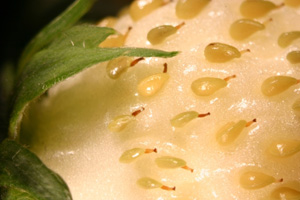|
Genetically-modified
strawberries are paving the way to more vitamin-rich fruit.
by Meagan White
 Photo courtesy
of Barry Whyte
Photo courtesy
of Barry Whyte
Transformed:
Foreign DNA has successfully been introduced in this ripening
strawberry .
|
|
The food pyramid is a guideline, but
considering the ridiculously low amounts of fruits and vegetables
people are eating in the Western world, it may have more in common
with the ancient monuments in Egypt. In 2000, 81% of men and 73%
of women in the United States reported eating fewer than the recommended
five servings of fruits and vegetables a day. Changing people's
eating habits is one way of dealing with the problem, but some molecular
biologists are taking a different approach: they are developing
a way to transfer genetic material into the genome of fruits to
increase the health benefits of even the fewest bites.
The scientists are specifically looking at strawberries, although the method can be applied to a variety of crops. Like all fruits, strawberries provide compounds that are essential to life. They are a major source of phytochemicals, antioxidants that are thought to reduce the risk of cancer, and they also happen to be an especially important source of vitamin C.
But although strawberries already have a high nutritional content, scientists claim that these fleshy, red fruits could be engineered to be even better for our health. Until now, it has been possible to engineer foods like corn and soybeans, but scientists haven't been able to manipulate the genome of the commercial strawberry in the way that they would like. The first step involves identifying the different genes in the strawberry and understanding their function and this requires a process called transformation to occur in the fruit. Transformation involves introducing foreign DNA from one type of cell into cells of a different organism with a different genome and to do this, scientists must engineer small, independent DNA molecules called plasmids to carry genetic information to the new host genome. The process is successful when genes from the foreign DNA are incorporated into the genome of the host, in this case the strawberry, causing a permanent change in its properties. So far, attempts at transformation in different varieties of strawberries have proved to be unsuccessful.
 Photo
courtesy of Barry Whyte
Photo
courtesy of Barry Whyte
Flowers of a strawberry plant that contains new genes.
|
This month, however, molecular biologists at the Virginia Bioinformatics Institute and the Department of Agriculture at Virginia Tech reported that they have developed a method of transformation that's both fast and thorough, transforming 95% of strawberry plants studied and generating a mature new plant in just four months. The biologists used a simpler berry, the Alpine strawberry, which has two sets of chromosomes instead of the eight sets in the commercial strawberry, Fragaria ananassa. It also has a shorter reproductive cycle, 14 to 15 weeks, which allowed them to produce more mutant plants in a shorter period of time.
To make the transformation process more efficient, the biologists used used a more aggressive strain of Agrobacterium, the cellular shuttle that introduces foreign DNA into the strawberry genome, to guarantee rapid infection. In transforming any given species-whether a fruit, vegetable, or slug- scientists need to know if the foreign DNA has been taken up and integrated. They ensured that very few non-transformed plants slipped through the selection process by using an antibiotic marker called hygromycin piggy-backed with a gene that codes for a specific marker protein known as Green Fluorescent Protein. By looking at the plant tissue under a fluorescent microscope, they were able to see clearly what tissue glowed green and therefore if the plants had been transformed or not with the DNA of interest.
"This method's efficiency is crucial for generating the large numbers of mutants we need to study the function of strawberry genes," said Dr. Janet Slovin, a molecular biologist at the United States Department of Agriculture in Beltsville MD. "It's a major step in developing a system that will allow scientists to identify commercially-important genes, like those that convey health benefits."
The method used by these scientists
could also lead to modifications in other fruits of the Rosaceae
family, which includes peaches, pears, plums, apples, cherries,
raspberries and almonds. The consumption of this family of fruits
ranks third in temperate regions.
For more info:
Strawberries by Design
http://www.eurekalert.org/pub_releases/2006-03/vt-sbd031006.php
High-efficiency transformation of strawberry
https://www.vbi.vt.edu/article/articleview/471/1/15/
|
